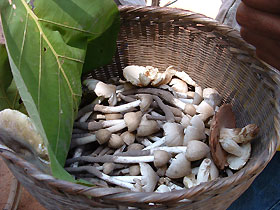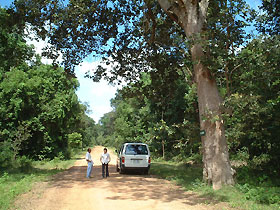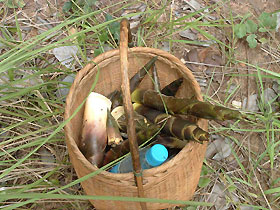| Period: 18 July - 10 August 2005. Country: Thailand |
|
(1) Ecological Characteristics of Remnant Patchy Forests in Yasothon Province, Northeast Thailand |
| ONOTERA Yuki (Division of Asian Area Studies) |
| Key Words: Patchy Forests, Villagers' Utilization, Species Composition, History, Ethnography |
 |
Wild het pluak
(Termitomyces sp. Amanitaceae) |
 |
|
A large tree in Kham-muang village |
 |
|
Wild no-mai |
(2) The forest, which was originally large and contiguous, has decreased in area and become fragmented. The reason for the reduction and fragmentation of the forest is human activities, though on the other hand, people remain attached to the forest for certain reasons. In some case, the remnant forests play a major role in terms of the conservation of biodiversity (cf. Lebbie and Guries 1995, Mgumia and Oba 2003). However, the character of the remnant patchy forests in the Asian and African regions have not been sufficiently studied yet (cf. Yamakoshi 2003).
It is believed that the ecological characteristics of patchy forests are affected not only by abiotic factors such as climate and soil condition, but also by the history of utilization. Therefore, it is appropriate to study the ecology of patchy forests in order to estimate the effects of human activities on the ecological environment.
For my pre-doctoral thesis, I conducted an ecological survey of several patchy forests, and discovered that basal area and tree species composition are affected by villagers' ways of utilization and their histories. However, other factors such as how the villagers use forest resources, soil characteristics and the original vegetation of the region have not yet been fully clarified.
The objective of this research is to clarify the dynamics of patchy forests and to estimate how the ecological environmental has been conserved from the viewpoint of ecological environment, history and people's utilization.
(3) During this research, I conducted an interview with the village leader of Pla-it village in Na-kae sub-district, Kham-khuan-kaeo district, Yasothon provice, Northeast Thailand, which is the research site that I used for my pre-doctoral thesis. The interview concerned the villagers' forest resource utilization, and was carried out during several days at the beginning of August 2005. Since several patchy forests remained, including satoyama (forests used for collecting fuel, daily consumption, fodder etc.) and sacred forests, it is appropriate to collect data from this village in order to clarify the forest utilization as well as ecological characteristics of patchy forests in this region to promote ecological conservation.
As part of the results, I investigated the use of thon ko (Lithocarpus sp. Fagaceae). In my pre-doctoral thesis, it was shown that this tree species has larger dominance in the satoyama. According to the village leader, thon ko can be easily chopped, the fruit is edible, and its boiled soup is good for mothers who just gave birth to a baby. Therefore, it is suggested that in order to clarify the dynamics of patchy forests, it is necessary to include information about how to use each of the tree species as well as the types and histories of patchy forests.
|



 21st Century COE Program
-Aiming for COE of Integrated Area Studies-
21st Century COE Program
-Aiming for COE of Integrated Area Studies-